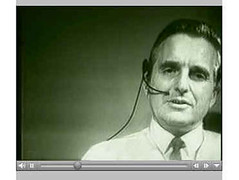
Locative Media are media of communication bound to a location. They are digital media applied to real places and thus triggering real social interactions. While mobile technologies such as the Global Positioning System (GPS), laptop computers and mobile phones enable locative media, they are not the goal for the development of projects in this field.
Media content is managed and organised externally of the device on a standard desktop or laptop. The device then downloads this formatted content with GPS coordinated triggers applied to each media sequence. As the location-aware device enters the selected area, satellites trigger the assigned media, designed to be of optimal relevance to the user and their surroundings. Location based media allows for the enhancement of any given environment offering explanation, analysis and detailed commentary on what the user is looking at through a combination of video, audio, images and text. The location-aware device can deliver interpretation of cities, parklands, heritage sites, sporting events or any other environment where location based media is required. The content production and pre-production are integral to the overall experience that is created and must have been performed with ultimate consideration of the location and the users position within that location. The media offers a depth to the environment beyond that which is immediately apparent, allowing revelations about background, history and current topical feeds.
The technology used in locative media projects is e.g. Global Positioning System (Tom Toms GPS), laptop computers, the mobile phone, Geographic Information System (GIS), Google Maps. Whereas GPS allows for the accurate detection of a specific location, mobile computers allow interactive media to be linked to this place. The GIS supplies arbitrary information about the geological, strategic or economic situation of a location. Google Maps give a visual representation of a specific place.
Art movements like Blast Theory is renowned internationally as one of the most adventurous artists' groups using interactive media. Led by Matt Adams, Ju Row Farr and Nick Tandavanitj the group has a team of seven and is based in Brighton. The group's work explores interactivity and the relationship between real and virtual space with a particular focus on the social and political aspects of technology. It confronts a media saturated world in which popular culture rules, using video, computers, performance, installation, mobile and online technologies to ask questions about the ideologies present in the information that envelops us.







